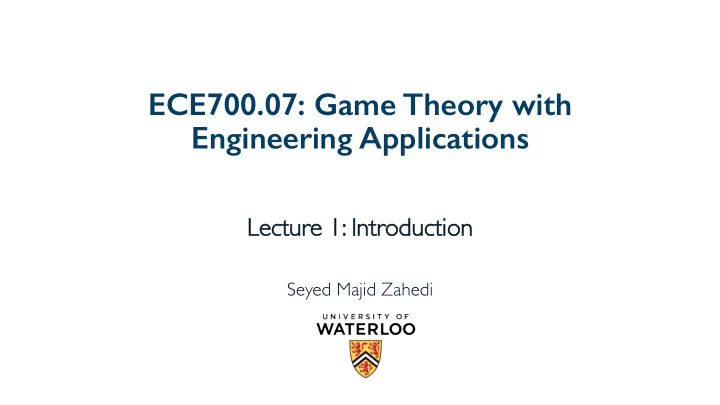

ECE700.07: Game Theory with Engineering Applications Le Lecture 1: Introduction Seyed Majid Zahedi
K-Beauty Contest Game • Let’s start with playing game • Everyone writes down a number between 0 and 100 • Person closest to k = 2/3 of the average wins • Example: • A says 50 - B says 10 - C says 90 • 2/3 of average(50, 10, 90) = 2/3 * 50 = 33.33 • A is closest (|50-33.33| = 16.67), so A wins
Overview • Course mechanics • Outline and topics • What is game theory? • What is mechanism design? • Examples
Course Mechanics • Course website • https://ece.uwaterloo.ca/~smzahedi/crs/ece700t7 • All class information, lecture notes, assignments, etc. • Office hour • W 16:00 to 17:00, or catch me after class, or send me email to setup meeting • Prerequisites • Basic knowledge of algorithms, probability, and optimization would be helpful
Course Requirements • Participation and pop quizzes 10% • Assignments 20% • Should be done individually, no group discussions • Midterm 30% (date TBD) • Project 40% • Could be done individually or in groups of 2 • Should be on applications of game theory to engineering research problem • Experimental study via simulation of game-theoretic mechanisms • Theoretical analysis of game-theoretic models
Text and References • There is no required textbook, here are useful references • Multi-agent Systems by Shoham and Leyton-Brown (freely available online) • Game Theory by Fudenberg and Tirole, • A Course in Game Theory by Osborne and Rubinstein (freely available onliene) • Microeconomic Theory by Mas-Colell, Whinston, and Green • Algorithmic Game Theory by Nisan, Roughgarden, Tardos, and Vazirani
Course Information • Introduce fundamentals of game theory and mechanism design • Emphasize on theory, mathematical models, and equilibrium notions • Study examples from engineered systems • E.g., routing games, resource allocation, strategies in electricity markets, etc.
Tentative Topics • Strategic form games • Extensive games with perfect information • Repeated games • Games with incomplete information • Mechanism design • Learning in games
Game Theory • Study of mathematical models of conflict and cooperation between intelligent rational decision- makers [Roger Myerson, Game Theory: Analysis of Conflict] John Forbes Nash Jr. 1928-2015 Fig. A Beautiful Mind, from s.hdnux.com
<latexit sha1_base64="jUmnqwqYRTJtXmplj5BJzvlt7HE=">ACJXicbVDLSgNBEJz1bXxFPXoZDIpel0R9OAh4MWbUYwGslFmJ706ODu7zvSKYUnwW7z4K148GETw5K84eQi+ChqKqm6u8JUCoOe9+6MjI6NT0xOTRdmZufmF4qLS6cmyTSHKk9komshMyCFgioKlFBLNbA4lHAWXu/3/LNb0EYk6gRbKTRidqlEJDhDK10U92KhXNrpdOg6jejG3WYQFIyLX9IdDYSiNRqYLDSAcEODmOFVGObH7XM7XvJcrw/6l/hDUiJDVC6K3aCZ8CwGhVwyY+q+l2IjZxoFl9AuBJmBlPFrdgl1SxWLwTy/pdtumaVJo0SbUsh7avfJ3IWG9OKQ9vZu9H89nrif149w2i3kQuVZgiKDxZFmaSY0F5ktCk0cJQtSxjXwt5K+RXTjKMNtmBD8H+/Jecbrm+5/pH26Xy4f0gjimyQlbJBvHJDimTA1IhVcLJA3kiL6TrPDrPzqvzNmgdcYRLpMfcD4+Acfko4E=</latexit> <latexit sha1_base64="jUmnqwqYRTJtXmplj5BJzvlt7HE=">ACJXicbVDLSgNBEJz1bXxFPXoZDIpel0R9OAh4MWbUYwGslFmJ706ODu7zvSKYUnwW7z4K148GETw5K84eQi+ChqKqm6u8JUCoOe9+6MjI6NT0xOTRdmZufmF4qLS6cmyTSHKk9komshMyCFgioKlFBLNbA4lHAWXu/3/LNb0EYk6gRbKTRidqlEJDhDK10U92KhXNrpdOg6jejG3WYQFIyLX9IdDYSiNRqYLDSAcEODmOFVGObH7XM7XvJcrw/6l/hDUiJDVC6K3aCZ8CwGhVwyY+q+l2IjZxoFl9AuBJmBlPFrdgl1SxWLwTy/pdtumaVJo0SbUsh7avfJ3IWG9OKQ9vZu9H89nrif149w2i3kQuVZgiKDxZFmaSY0F5ktCk0cJQtSxjXwt5K+RXTjKMNtmBD8H+/Jecbrm+5/pH26Xy4f0gjimyQlbJBvHJDimTA1IhVcLJA3kiL6TrPDrPzqvzNmgdcYRLpMfcD4+Acfko4E=</latexit> <latexit sha1_base64="jUmnqwqYRTJtXmplj5BJzvlt7HE=">ACJXicbVDLSgNBEJz1bXxFPXoZDIpel0R9OAh4MWbUYwGslFmJ706ODu7zvSKYUnwW7z4K148GETw5K84eQi+ChqKqm6u8JUCoOe9+6MjI6NT0xOTRdmZufmF4qLS6cmyTSHKk9komshMyCFgioKlFBLNbA4lHAWXu/3/LNb0EYk6gRbKTRidqlEJDhDK10U92KhXNrpdOg6jejG3WYQFIyLX9IdDYSiNRqYLDSAcEODmOFVGObH7XM7XvJcrw/6l/hDUiJDVC6K3aCZ8CwGhVwyY+q+l2IjZxoFl9AuBJmBlPFrdgl1SxWLwTy/pdtumaVJo0SbUsh7avfJ3IWG9OKQ9vZu9H89nrif149w2i3kQuVZgiKDxZFmaSY0F5ktCk0cJQtSxjXwt5K+RXTjKMNtmBD8H+/Jecbrm+5/pH26Xy4f0gjimyQlbJBvHJDimTA1IhVcLJA3kiL6TrPDrPzqvzNmgdcYRLpMfcD4+Acfko4E=</latexit> <latexit sha1_base64="jUmnqwqYRTJtXmplj5BJzvlt7HE=">ACJXicbVDLSgNBEJz1bXxFPXoZDIpel0R9OAh4MWbUYwGslFmJ706ODu7zvSKYUnwW7z4K148GETw5K84eQi+ChqKqm6u8JUCoOe9+6MjI6NT0xOTRdmZufmF4qLS6cmyTSHKk9komshMyCFgioKlFBLNbA4lHAWXu/3/LNb0EYk6gRbKTRidqlEJDhDK10U92KhXNrpdOg6jejG3WYQFIyLX9IdDYSiNRqYLDSAcEODmOFVGObH7XM7XvJcrw/6l/hDUiJDVC6K3aCZ8CwGhVwyY+q+l2IjZxoFl9AuBJmBlPFrdgl1SxWLwTy/pdtumaVJo0SbUsh7avfJ3IWG9OKQ9vZu9H89nrif149w2i3kQuVZgiKDxZFmaSY0F5ktCk0cJQtSxjXwt5K+RXTjKMNtmBD8H+/Jecbrm+5/pH26Xy4f0gjimyQlbJBvHJDimTA1IhVcLJA3kiL6TrPDrPzqvzNmgdcYRLpMfcD4+Acfko4E=</latexit> Game Theory • Op Optimization on theor ory : optimize single objective f ( x ) min. s.t. x ∈ X ⊆ R n • Ga Game theory : study multi-agent decision making to understand • Competition, coordination, and cooperation among self-interested agents
Mechanism Design • Mechanism design is a field in economics and game theory that takes an engineering approach to designing economic mechanisms or incentives, toward desired objectives, in strategic settings, where players act rationally [Wikipedia Aug. 2018]
Example I: Resource Allocation • Design resource management systems robust to strategic behavior • Agents manipulate management systems • Real-life Examples • Yahoo! MapReduce datacenter [A. Ghodsi et al. 2011] Map slots were congested, users ran long reduce tasks • Google Borg [A. Verma et al. 2015] Users inflated demands to avoid colocated tasks Users deflated demands to fit in on any machine 12
Example II: Electricity Markets • Generators supply energy into grid • Operator balances demand/supply • Generators can strategically curtail generation to manipulate prices www.euneighbours.eu • Electricity markets should be carefully studied, designed and regulated
Example III: Blockchains www.blockchains-expert.com • Design protocols that guarantee • No coalition has incentives to deviate • If some coalition deviates, then no participating agent is worse of
Example IV: Autonomous Cars • Autonomous cars constantly interact with other drivers • Different drivers deploy different decision making policies • Safety needs to be verified • Requires 275 million miles of driving assets.aspeninstitute.org • Game-theoretic traffic models could be used to test, compare, and calibrate control systems
Example V: Real-world Security [TEAMCORE group (USC)] • Airport security: where to put checkpoints? • Deployed at LAX • Federal Air Marshals: which flights get FAM? • USA Coast Guard: which routs should be followed? • Deployed in Boston Harbor
Questions?
Acknowledgement • This lecture is a slightly modified version of ones prepared by • Asu Ozdaglar [MIT 6.254] • Vincent Conitzer [Duke CPS 590.4]
Recommend
More recommend